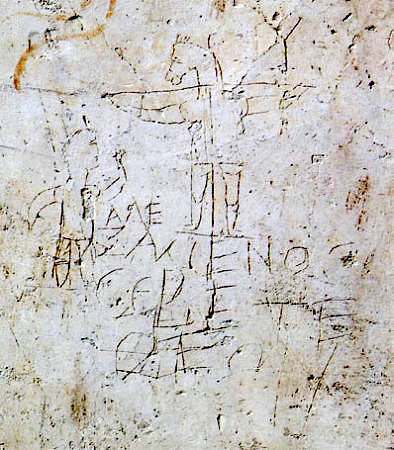One of the oldest known depictions of Jesus Christ isn’t found in a humble chapel in Bethlehem, nor is it a fine work of art kept in the shady basements of the Vatican. In fact, it’s a piece of crudely drawn Roman graffito that shows a person with the head of a donkey being crucified.
Known as the Alexamenos Graffito, the disrespectful doodle dates to the late second or early third century CE, making it one of the earliest pictorial representations of the crucified Christ. This was a time before Christianity became the official religion of the Roman Empire – and clearly, the burgeoning religion wasn’t popular with some.
It depicts a human-like figure with the head of a donkey affixed to a crucifix. On the left, a man is seen with his left arm pointing towards the ass-headed character.
Along with the illustration, it features ancient Greek text that translates to something like: “Alexamenos worships [his] god.” Although its meaning is up for interpretation, it is widely believed that the graffito was intended to mock a Christian named Alexamenos for his belief in the unfamiliar, new religion.
The graffiti was discovered in 1857 on the Palatine Hill, one of the oldest parts of Rome, on the wall of a building annexed to the imperial palace where slaves received their training.
Who knows, perhaps it was one of the empire’s disgruntled slaves who scratched it onto the wall, poking fun at one of their comrades as they underwent training. Then again, it could have been the handiwork of a bored soldier or any other citizen, as the ancient Romans are known for their graffiti.

A low-res image of the original Alexamenos graffito.
But why depict Jesus as a donkey? During this chapter of Imperial Rome, Jewish people and early Christians were often mocked and persecuted for practicing onolatry, the act of worshipping donkeys or mules.
The origins of this bizarre misunderstanding aren’t fully understood, although it most likely started with confusion between believers of the Hebrew Bible and worship of the ancient Egyptian god Set, who is represented as a man with the head of a donkey and often associated with the animal.
Of course, the Romans eventually changed their tune when it came to Christianity. Around 312 CE, Emperor Constantine had adopted Christianity and, by 380 CE, Emperor Theodosius I declared Christianity to be the official religion of the Romans.
The artwork still lives near its original site at the Palatine Museum of Rome along with many other ancient artifacts from the long-gone empire. As you can see, time hasn’t been too kind to the artwork, and it’s very hard to discern its contents with the naked eye today.
There’s plenty of ancient graffiti to feast your eyes on elsewhere, though. One of the most common motifs seen throughout the graffiti of the Roman Empire was a cartoonishly large penis (some things never change, eh?).
Historians like to claim that ancient Romans didn’t scrawl dick pics as a dirty joke, but as symbols of fortune and fertility – although judging by the Alexamenos Graffito, they clearly weren’t scared of offending people with their street drawings.
Source Link: One Of The Earliest Depictions Of Jesus Shows Him With A Donkey Head